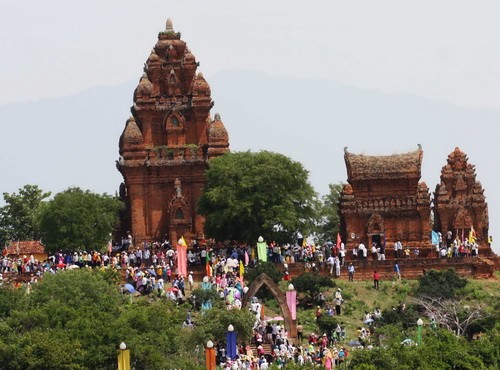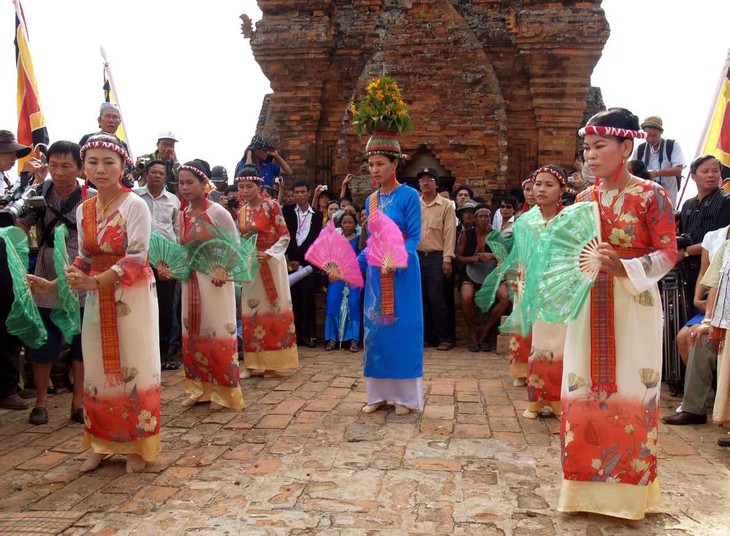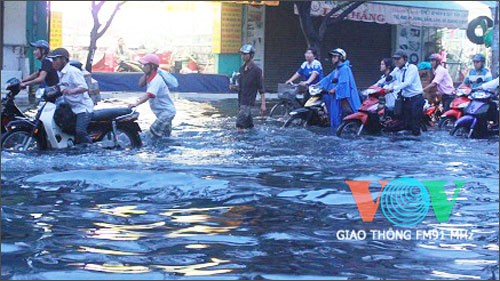Hello and welcome to VOV’s Letter Box, our weekly feature dedicated to our listeners throughout the world. We are Mai Phuong and Ngoc Huyen.
A: Dear listeners, as the year enters its final days, everybody in the world including the Vietnamese seem to be getting busier and more in a rush. The hurried atmosphere has invaded VOV’s offices, where we are busily preparing our year-end programs and New Year’s gifts for our listeners around the world.
B: As Phuong has mentioned, we’re sending out VOV’s 2014 calendars and frequency lists to approximately 1,000 listeners around the world. These gifts are our thanks to you for listening and contributing to our program.
A: This week, we’d like to welcome Kurt Norlin of Sweden, a radio lover who began listening to radio in 1959 when he was 15 years old. Kurt sent us a picture of several receivers he owns and he seems very proud of them. Kurt reported listening to VOV programs last March and most recently on October 25th on 9625 khz at 17 UTC. Kurt, your reception report qualifies you for a QSL card and we hope to hear more from you.

Cham towers in Ninh Thuan province |
B: Next, we’d like to thank Gerry Neumann for his report on listening to a VOV English broadcast on 5955 Khz at 18UTC with SINPO rated all 5s. Gerry said he was particularly interested in our Discovery Vietnam segments about a pottery museum on the outskirts of Hanoi and a Cham sculpture museum in Da Nang. Gerry wrote: “On previous trips to Vietnam, I visited that museum and have also been to My Son and the Po Na Gar temple in Nha Trang. I would be interested in learning more about the Cham culture in Vietnam”.
A: Well, Gerry, it is estimated that there are more than 160,000 Cham ethnic minority people living in south-central Viet Nam, mainly in the provinces of Ninh Thuan, Binh Thuan and An Giang. The Cham have a long cultural tradition which has flourished since the time of the Champa Kingdom 5 centuries ago.
B: The Cham ethnic groups speak a dialect of the Malayo-Polynesian language and are related to the Raglai, Ede, Chu Ru and Gia Rai groups in Vietnam. The Cham people share ethnic similarities with Indonesians, Malaysians and Bruneians in South East Asia and have a culture heavily influenced by Indian culture. The Cham include a number of local groups with varying religions, beliefs and culture. Some attend mosques, while others practice their religion in pagodas or tower temples.

Folk dances of Cham people |
A: The 4 main Cham groups differ by religion. The majority of Cham in Vietnam are Cham Balamon or Hindu. The second group is Cham Bani or old Muslim. The 3rd group Cham Islam is modern Muslim. The 4th group, the Cham Hroi, do not follow any religion”.
B: Religious differences have led to differences in culture, customs, and social practices. As Ethnology researcher Le Duy Dai explains, their cultures are basically similar, but there are some differences. For example, the Cham Balamon and Cham Bani are matriarchal, while the Cham Islam are patriarchal. Their clothing is similar. The Cham Balamon and Cham Bani live in low houses on stilts, which no longer exist in Ninh Thuan and Binh Thuan. The Cham Islam in Chau Doc and the Cham Hroi live in houses on long stilts.
B: The Cham culture has many unique traditions which contribute to the diversity and richness of Vietnam’s multi-ethnic culture. The Cham are famous for rich popular literature which includes hundreds of stories, sayings, idioms, puzzles and songs which make up a precious literary tradition.
A: During the urbanization that has occurred in recent years, the lives of Cham people have undergone changes but traditional values of the authentic Cham culture, the social norms for behavior, and the role, responsibilities, and obligations of families are still strictly honored.
B: Well, that was a short take on the Cham ethnic minority group in Vietnam. We’ll delve into this topic further in later broadcasts. So, stay tuned.
A: Here’s an email from Andrew Siranni of Ontario, Canada. Andrew reported listening to our program on November 23 on 6175 Khz from 1:00 to 1:25 UTC using a Sangean ATS 818 receiver with a 7 m wire antenna. He wrote: “I rated reception as S of 3, I of 2 and O of 3. Your program was clearly audible but suffered from adjacent channel interference from a Brazilian broadcaster on 6180 Khz. I enjoyed hearing about your country and for this reason, I am a dedicated shortwave listener. Keep up your good work”.
B: Andrew, we greatly appreciate your reception report and are sending you a QSL card to verify it. Next is an email from Christer Brunstrom of Sweden. He wrote: “I was sorry to hear about the loss of human lives in the recent hurricane which struck Vietnam’s coastal areas. We are also getting more extreme weather in Sweden but our storms cannot be compared with those that you experience. In Warsaw, there has been a conference to discuss how to address the climate issue, but, as always, they have not really delivered any positive actions. It’s getting cooler here in Sweden and we have had quite a lot of snow in the northern part of the country”.
B: According to a report of the United Nations Environment Program, the trend of recent climate change in Viet Nam is beyond the level of natural change. Temperatures have increased 0.05-0.20°C and the sea level has risen 2-4 cm per decade in the last 50 years. According to projections, by the end of the 21st century, the annual average temperature in Viet Nam will have increased between 1.1 and 3.6°C, rainfall is likely to increase 1.0 to 10.1%, and the sea level is likely to rise between 65 and 100cm.

Rising tides in Ho Chi Minh City |
A: The impacts of climate change for the seven climatic zones of Vietnam will be different, but are likely to be critical for water resources and key socio-economic sectors such as agriculture, forestry, fisheries, energy, transportation and health. Vietnam is currently developing a low carbon economy and mitigation policies aimed at reducing green house gas emissions in these sectors. It is also developing a number of strategies to adapt to the impacts of climate change so as to reduce the vulnerability of society.
B: Let’s continue with letters from our listeners. Bhaikan Hazarika reported listening to our program on November 25, calling it an amazing fantastic program. He said he was impressed with the Colorful Vietnam-Vietnam’s 54 ethnic groups segment that featured Vietnam’s Thai ethnic groups. Bhaikan said he enjoyed learning about the Thai people’s lifestyle, culture and sports.
A: Thank you Bhaikan for your comments. We’re sending you a QSL card to confirm your report. On today’s program, we’d like to congratulate Rada Dewan Rafiqul of Bangladesh and our other Bangladeshi listeners on your Victory Day, December 16. We have sent you VOV’s 2014 Calendar and other souvenirs to add to your DX exhibition on this occasion. We hope they arrive in time.
B: We’d like to acknowledge letters and emails from Hannu Kliski of Finland, Parisi Asih of Indonesia, Peter Ng of Malaysia, Ratan Kumar Paul, Jayanta Chakrabarty and Joy Mondal of India, Muneer K.P of United Arab Emirates, and Ashik Eqbal Tokon of Bangladesh. We greatly appreciate your listening. We’ll verify your reception reports and send you our QSL cards soon.
A: That’s it for today’s Letter Box. We welcome your feedback at: English section, Overseas Service, Radio Voice of Vietnam, 45 Ba Trieu Street, Hanoi, Vietnam. Or you can email us at: englishsection@vov.org.vn. You’re invited to visit us online at www.vovworld.vn, where you can hear both live and recorded programs. Thanks for being with us. Goodbye.